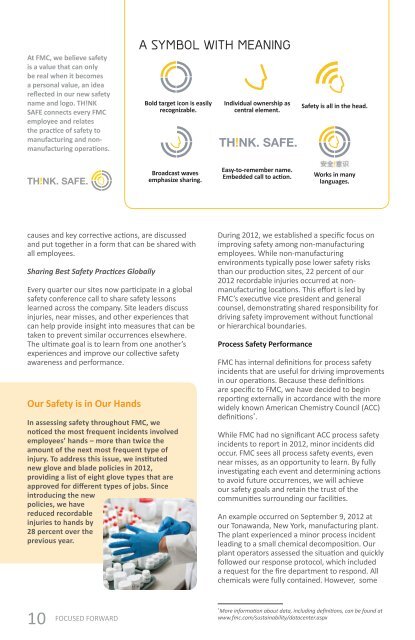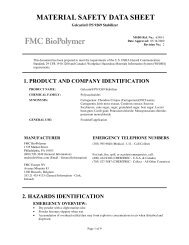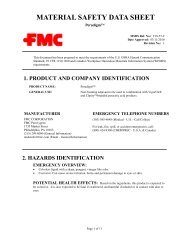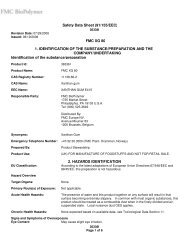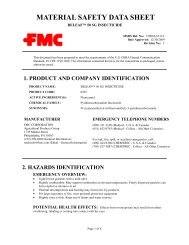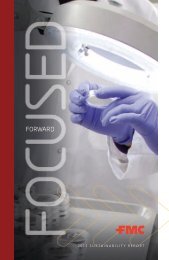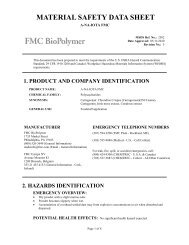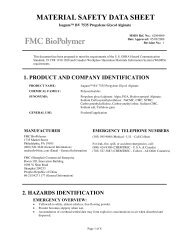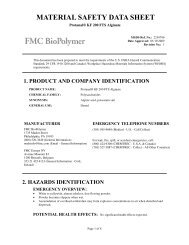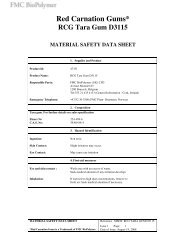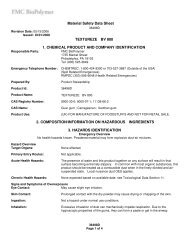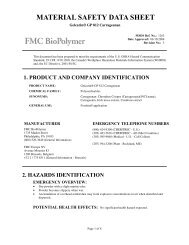Read the Report - FMC Corporation
Read the Report - FMC Corporation
Read the Report - FMC Corporation
You also want an ePaper? Increase the reach of your titles
YUMPU automatically turns print PDFs into web optimized ePapers that Google loves.
At <strong>FMC</strong>, we believe safety<br />
is a value that can only<br />
be real when it becomes<br />
a personal value, an idea<br />
reflected in our new safety<br />
name and logo. TH!NK<br />
SAFE connects every <strong>FMC</strong><br />
employee and relates<br />
<strong>the</strong> practice of safety to<br />
manufacturing and nonmanufacturing<br />
operations.<br />
causes and key corrective actions, are discussed<br />
and put toge<strong>the</strong>r in a form that can be shared with<br />
all employees.<br />
Sharing Best Safety Practices Globally<br />
Every quarter our sites now participate in a global<br />
safety conference call to share safety lessons<br />
learned across <strong>the</strong> company. Site leaders discuss<br />
injuries, near misses, and o<strong>the</strong>r experiences that<br />
can help provide insight into measures that can be<br />
taken to prevent similar occurrences elsewhere.<br />
The ultimate goal is to learn from one ano<strong>the</strong>r’s<br />
experiences and improve our collective safety<br />
awareness and performance.<br />
Our Safety is in Our Hands<br />
In assessing safety throughout <strong>FMC</strong>, we<br />
noticed <strong>the</strong> most frequent incidents involved<br />
employees’ hands – more than twice <strong>the</strong><br />
amount of <strong>the</strong> next most frequent type of<br />
injury. To address this issue, we instituted<br />
new glove and blade policies in 2012,<br />
providing a list of eight glove types that are<br />
approved for different types of jobs. Since<br />
introducing <strong>the</strong> new<br />
policies, we have<br />
reduced recordable<br />
injuries to hands by<br />
28 percent over <strong>the</strong><br />
previous year.<br />
10<br />
FOCUSED FORWARD<br />
A SYMBOL WITh MEANING<br />
Bold target icon is easily<br />
recognizable.<br />
Broadcast waves<br />
emphasize sharing.<br />
Individual ownership as<br />
central element.<br />
Easy-to-remember name.<br />
Embedded call to action.<br />
During 2012, we established a specific focus on<br />
improving safety among non-manufacturing<br />
employees. While non-manufacturing<br />
environments typically pose lower safety risks<br />
than our production sites, 22 percent of our<br />
2012 recordable injuries occurred at nonmanufacturing<br />
locations. This effort is led by<br />
<strong>FMC</strong>’s executive vice president and general<br />
counsel, demonstrating shared responsibility for<br />
driving safety improvement without functional<br />
or hierarchical boundaries.<br />
Process Safety Performance<br />
Safety is all in <strong>the</strong> head.<br />
Works in many<br />
languages.<br />
<strong>FMC</strong> has internal definitions for process safety<br />
incidents that are useful for driving improvements<br />
in our operations. Because <strong>the</strong>se definitions<br />
are specific to <strong>FMC</strong>, we have decided to begin<br />
reporting externally in accordance with <strong>the</strong> more<br />
widely known American Chemistry Council (ACC)<br />
definitions * .<br />
While <strong>FMC</strong> had no significant ACC process safety<br />
incidents to report in 2012, minor incidents did<br />
occur. <strong>FMC</strong> sees all process safety events, even<br />
near misses, as an opportunity to learn. By fully<br />
investigating each event and determining actions<br />
to avoid future occurrences, we will achieve<br />
our safety goals and retain <strong>the</strong> trust of <strong>the</strong><br />
communities surrounding our facilities.<br />
An example occurred on September 9, 2012 at<br />
our Tonawanda, New York, manufacturing plant.<br />
The plant experienced a minor process incident<br />
leading to a small chemical decomposition. Our<br />
plant operators assessed <strong>the</strong> situation and quickly<br />
followed our response protocol, which included<br />
a request for <strong>the</strong> fire department to respond. All<br />
chemicals were fully contained. However, some<br />
* More information about data, including definitions, can be found at<br />
www.fmc.com/sustainability/datacenter.aspx


